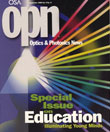
September 1998 Issue
- Optics Educations: Encouraging an Integrated Approach
- Workforce Development for Optics and Photonics
- Bridging the Gap Between Teaching and Learning in Geometrical Optics: The Role of Research
- PEER INSTRUCTION: An Interactive Approach for Large Lecture Classes
- Science Literacy For All: An Achievable Goal?
- Educational Outreach: A Practical Approach
- Citation Managers
- Evanescent Coupling: Part 1
- Low Magnification Parfocal Microscope Objective
- Browse all Issues
Feature Articles
Optics Educations: Encouraging an Integrated Approach
Optics has traditionally fallen under the academic disciplines of physics and engineering. But with optical technology playing an increasing role in modern life, the need for individuals studying and universities teaching optical science and engineering as its own discipline is growing.
by Dennis G. Hall and Richard C. PowellWorkforce Development for Optics and Photonics
The need for photonics technicians is rapidly increasing, but the present and future needs will most likely not be met. How do we encourage students to enter this continually transforming field, and adequately prepare them to become vital professionals?
by Darrell M. Hull and Nicholas MassaBridging the Gap Between Teaching and Learning in Geometrical Optics: The Role of Research
Research on the learning and teaching of physics is discipline-specific, focuses on the state of the student, and can be generalized beyond a particular instructor, course, or institution. As an example, this article describes how results from research have contributed to the improvement of student learning in geometrical optics.
by Paula R.L. Heron and Lillian C. McDermottPEER INSTRUCTION: An Interactive Approach for Large Lecture Classes
Peer Instruction, a method of actively involving students in lectures, avoids problems traditionally associated with conventional teaching, and increases students' understanding of concepts and test performance.
by Catherine H. CrouchScience Literacy For All: An Achievable Goal?
“What the future holds in store for individual human beings, the nation, and the world depends largely on the wisdom with which humans use science and technology. And that, in turn, depends on the character, distribution, and effectiveness of the education that people receive.”—Science for All Americans, AAAS, 1989.
by George D. NelsonEducational Outreach: A Practical Approach
Optics need not be something only learned in college. There are plenty of opportunities for teaching optics to students of all ages, using a variety of venues.
by Peter J. Delfyett and Robert E. NahoryCitation Managers
Recently, an OSA member requested that formatting "tags" recognizable to a citation manager be included with OSA online information. As it happens, that is an already established goal of OSA's electronic publications department— one they are currently working on. But, what is a citation manager and why is someone so eager to use one on OpticsNet?
by Bob JopsonEvanescent Coupling: Part 1
Evanescent electromagnetic waves abound in the vicinity of luminous objects. These waves, consisting of oscillating electric and magnetic fields in regions of space immediately surrounding an object, do not transfer their stored energy to other regions and, therefore, remain localized in space. Like all electromagnetic waves, the behavior of evanescent waves is governed by Maxwell's equations, and their presence in the vicinity of an object helps to satisfy the requirements of field continuity at the object's boundaries. Evanescent fields decay exponentially with distance away from the object's surface, making them exceedingly difficult to detect at distances much greater than a wavelength.
by Masud MansuripurLow Magnification Parfocal Microscope Objective
At first glance it would seem that the design of an ultra-low-power microscope objective of about 2x magnification would be a trivial task. The required focal length is on the order of 70-100 mm, which is large compared to high power microscope objectives, but modest compared to many photographic objectives, and the NA need only be about 0.1. However, microscope objectives are usually designed to work in sets of three or four different focal lengths, all mounted to a turret.
by J. Brian Caldwell

![A multiplexed image of a human tonsil acquired. [NIAID] using the iterative bleaching extends multiplexity (IBEX) method.](https://opnmedia.blob.core.windows.net/$web/opn/media/images/articles/2024/0424/departments/202404-cover-web.jpg?ext=.jpg)
